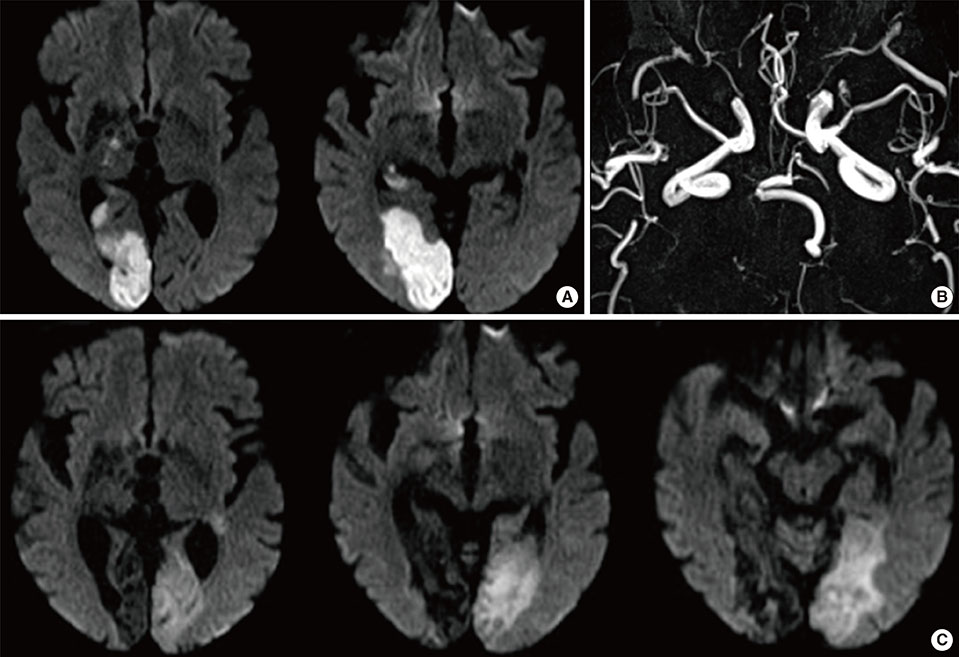Dement Neurocogn Disord.
2014 Dec;13(4):150-152. 10.12779/dnd.2014.13.4.150.
Kluver-Bucy Syndrome Following Bilateral Posterior Cerebral Artery Infarction
- Affiliations
-
- 1Department of Neurology, Veterans Health Service Medical Center, Seoul, Korea. kh21762@hanmail.net
- KMID: 2443081
- DOI: http://doi.org/10.12779/dnd.2014.13.4.150
Abstract
- Kluver-Bucy syndrome is defined as a rare neurobehavioral disorder with hyperphagia, hyperorality, hypersexuality, and visual agnosia. This syndrome is usually resulting from bilateral lesions of the anterior temporal lobe including amygdala. Although it could occur after various diseases, stroke is uncommon etiology. We report a patient with Kluver-Bucy syndrome due to bilateral posterior cerebral artery territory infarction.
Keyword
MeSH Terms
Figure
Reference
-
1. Kluver H, Bucy PC. Preliminary analysis of functions of the temporal lobes in monkeys. 1939. J Neuropsychiatry Clin Neurosci. 1997; 9:606–620.2. Lilly R, Cummings JL, Benson DF, Frankel M. The human Kluver-Bucy syndrome. Neurology. 1983; 33:1141–1145.
Article3. Aygun D, Guven H, Altintop L, Doganay Z. Postcontusional Kluver-Bucy syndrome. Am J Emerg Med. 2003; 21:246–247.
Article4. Ku BD, Yoon SS. Relapsing herpes simplex encephalitis resulting in Kluver-Bucy syndrome. Intern Med. 2011; 50:763–766.5. Ghika-Schmid F, Assal G, De Tribolet N, Regli F. Kluver-Bucy syndrome after left anterior temporal resection. Neuropsychologia. 1995; 33:101–113.
Article6. Chou CL, Lin YJ, Sheu YL, Lin CJ, Hseuh IH. Persistent Kluver-Bucy syndrome after bilateral temporal lobe infarction. Acta Neurol Taiwan. 2008; 17:199–202.7. Müller A, Baumgartner RW, Rohrenbach C, Regard M. Persistent Kluver-Bucy syndrome after bilateral thalamic infarction. Neuropsychiatry Neuropsychol Behav Neurol. 1999; 12:136–139.8. Hayman LA, Rexer JL, Pavol MA, Strite D, Meyers CA. Kluver-Bucy syndrome after bilateral selective damage of amygdala and its cortical connections. J Neuropsychiatry Clin Neurosci. 1998; 10:354–358.
Article9. Geschwind N. Disconnexion syndromes in animals and man. I. Brain. 1965; 88:237–294.10. Stewart JT. Carbamazepine treatment of a patient with Kluver-Bucy syndrome. J Clin Psychiatry. 1985; 46:496–497.11. Hooshmand H, Sepdham T, Vries JK. Kluver-Bucy syndrome. Successful treatment with carbamazepine. JAMA. 1974; 229:1782.
Article
- Full Text Links
- Actions
-
Cited
- CITED
-
- Close
- Share
- Similar articles
-
- Bilateral Anterior Opercular Syndrome With Partial Kluver-Bucy Syndrome in a Stroke Patient: A Case Report
- Relapsing Herpes Simplex Encephalitis Resulting in Kluver-Bucy Syndrome
- Bilateral Anterior Cerebral Artery Infarction Associated with Reversible Cerebral Vasoconstriction Syndrome
- Transient Hyperorality during Automotor Seizure in a Patient with Right Temporal Lobe Epilepsy. Epileptic Kluver-Bucy Syndrome?
- Moyamoya Syndrome Associated With Hashimoto's Thyroiditis


